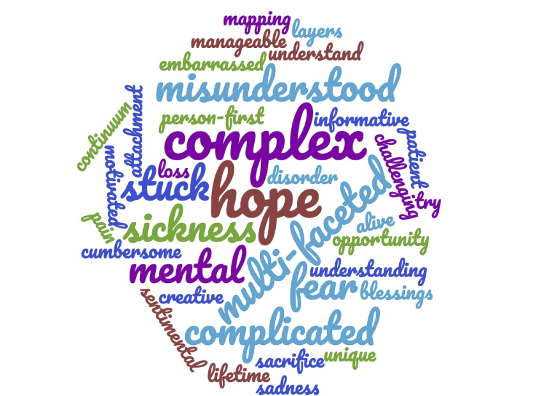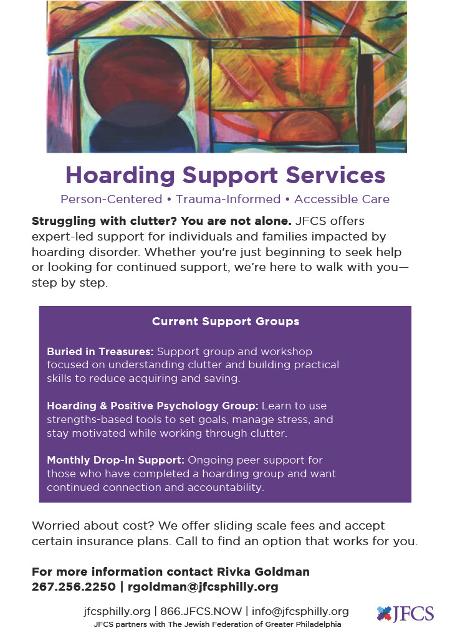Featured Resource: Hoarding Help from Jewish Family & Children Service
Visit jfcsphilly.org/hoarding-program for more information!
There is hope for hoarding.
Hoarding is a mental health condition that affects approximately 2-5% of the population. That means there are between 30,000 to 75,000 Philadelphians who have hoarding behaviors.
People with hoarding behaviors have a strong attachment to possessions. Over time, this attachment can lead to an accumulation of stuff that prevents the use of space as it was intended.
For example, hoarding may result in beds that can’t be slept in, kitchens that cannot be cooked in or cars that cannot be driven. Without support, hoarding may lead to health and safety risks for individuals, families, first responders and neighbors.
Like any other mental health condition, simply telling a person they need to change their behaviors doesn’t help. But providing resources and support does. It’s important to connect with the people involved, and not just focus on the stuff.
While there is no single cause to hoarding disorder and no one-size-fits all approach for those who are ready to change, this website is designed to guide you no matter who you are or what your role may be.

There are many pathways to a healthy and safe home.

Step 1: Get Educated
There are many pathways to a healthy and safe home, but they all begin with education. It's important to take some time and learn about hoarding disorder to understand how it operates and explore intervention options.
For Everyone
- Watch a video or a movie.
- Visit hoarding.iocdf.org
- Read Stuff or Buried in Treasures or Digging Out
- Define hoarding disorder.
- Review Initial Benchmarks for a Healthy & Safe Home
For a Person with Hoarding Behaviors
- Read Buried in Treasures
For a Family Member or Friend
- Read Digging Out
For a Social Service Professional
- Read the Hoarding Handbook or Compulsive Hoarding and Acquiring Workbook or the ICD Guide to Collaborating with Professional Organizers
For a Landlord, Inspector, or Legal Professional
- Read Stuff
- Review Best Practices for Inspections and Enforcement
For a complete list, review our Educational Materials .

Step 2: Team up for Change
As you begin to understand hoarding, the next step towards a healthy and safe home is to build a team of people with specific roles.
-
The person who is hoarding sets goals and develops skills to sort, categorize, organize and discard.
-
Friends, family and peers support the person’s recovery. Look. Don’t touch. Really listen. Don’t judge. Express hope.
-
A professional organizer, case manager or social service professional creates a plan and helps as a coach. See accessing case management or professional organizing.
-
A counselor or therapist addresses mental health issues like grief and trauma. See accessing mental health services.
-
An attorney or legal aid associate helps respond to outside pressure. See accessing legal services.
-
A landlord or code enforcement inspector collaborates with the team to clarify compliance and set priorities. Review best practices for inspections and enforcement.

Step 3: Assess the Home
As you learn about hoarding and build a team, the next step is to use available assessment tools to build a common language and get everyone on the same page about priorities.
To assess the volume of stuff:
- Clutter Image Rating scale (Frost)
To assess the risks in the home:
- HOMES Assessment (Bratiotis)
- Initial Benchmarks for a Healthy and Safe Home (PHTF)
To assess activities of daily living:
- Activities of Daily Living - Hoarding (Frost; Steketee)
For a complete list, review our Assessment Tools.

Step 4: Take Action
Once you've found your team and assessed the space, it's time to begin sorting, organizing and discarding. People with hoarding behaviors have difficulty letting go, so it's important for support people to be patient and compassionate, celebrating small victories, particularly early on.
- Identify the highest risk areas and start there. This may be near the kitchen stove, by a heater or in the bathroom.
- Aim to reach the initial benchmarks in this high risk area.
- Make rules for how many of each item can stay in this area.
- Work in 15-20 minute sessions and take breaks.
- Make rules for new things coming into the home.
- Donate items instead discarding.
- Consider seeking case management, professional organizing or mental health counseling.
- Consider whether a cleanout is needed. Completely cleaning out a home often makes hoarding worse. If you need to focus on safety quickly, consider targeted cleaning services that will go at your pace.
For landlords and property managers, there are some additional resources that may be helpful.
- Consider a fire safety inspection.
- Find pest management services.

Step 5: Get Ongoing Support
As people with hoarding disorder reduce the harm in their home, they may need additional support maintaining their success.
- Join a support group.
- Consider home healthcare services to help maintain.
- If someone is in crisis or their hoarding worsens dramatically, consider involving protective services.

